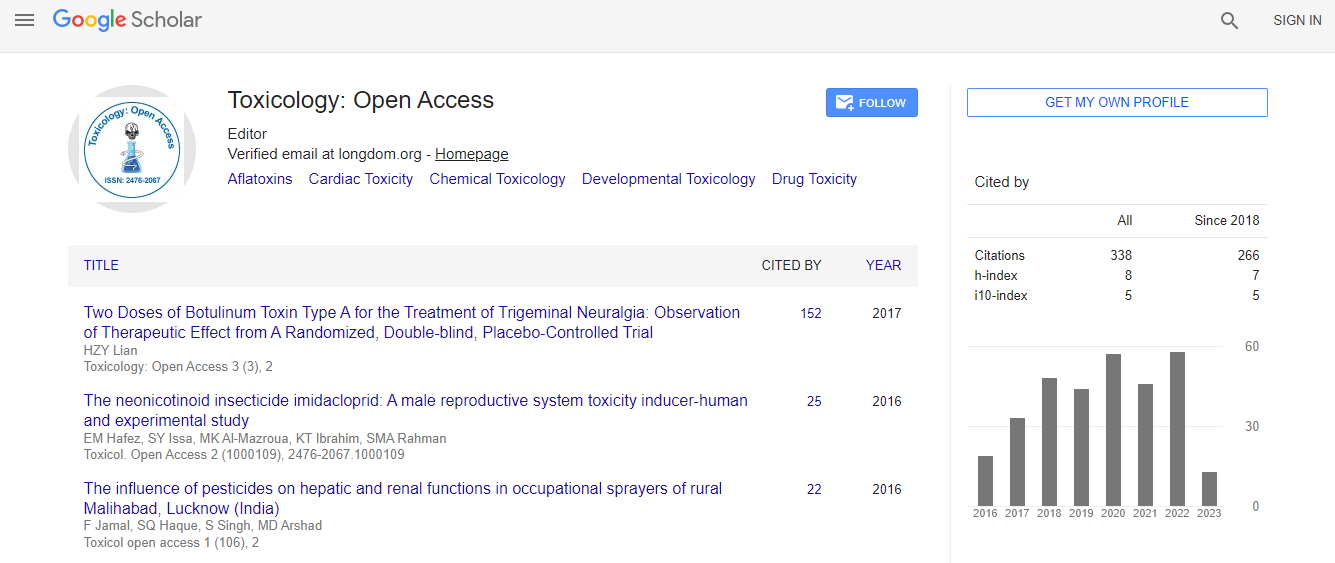Our Group organises 3000+ Global Conferenceseries Events every year across USA, Europe & Asia with support from 1000 more scientific Societies and Publishes 700+ Open Access Journals which contains over 50000 eminent personalities, reputed scientists as editorial board members.
Open Access Journals gaining more Readers and Citations
700 Journals and 15,000,000 Readers Each Journal is getting 25,000+ Readers
Google Scholar citation report
Citations : 336
Toxicology: Open Access received 336 citations as per Google Scholar report
Indexed In
- Google Scholar
- RefSeek
- Hamdard University
- EBSCO A-Z
- Geneva Foundation for Medical Education and Research
- Euro Pub
- ICMJE
Useful Links
Related Subjects
Share This Page
Aberrations in Chironomidae (Diptera) genomes induced by various environmental stress factors
8th World Congress on Toxicology and Pharmacology
Pragya Khanna
Government College Women-J&K, India
Posters & Accepted Abstracts: Toxicol Open Access
Abstract
Chironomids represent one of the most important groups of aquatic invertebrates. The larvae and pupae of most species of chironomids occur in freshwater, though they are also prevalent in marine, brackish water and terrestrial habitats. In many aquatic habitats this group constitutes more than half of the total number of macro-invertebrate species present. As it is the invertebrates are known to be an appropriate tool for assessment of the state of aquatic ecosystems. The larvae display exceptionally wide range of sensitivity to environmental parameters such as DO, pH, salinity, substrate, and pollution by organic wastes, heavy metals and contaminants, and also play an important role in indicating radioactive pollution. The chironomid larvae form an integral link in aquatic food chain and constitute a biological connection between aquatic and terrestrial habitat and ostensibly human is intimately linked to these systems. In particular Chironomus plumosus, the most favored chironomid is generally chosen for the following reasons: It possesses a low diploid chromosome set (2n=8), the salivary polytene chromosomes have a distinct and well described band structure which permits detailed analysis of structural and functional aberrations and chromosomes I, II and III contain well-expressed nucleolar organizers (NORs) and welldeveloped Balbiani rings (BR1 and BR2) are present in chromosome G. NOR and BRs are known to be very sensitive to stress and could be used as good model to examine the genotoxicity of pollutants. The polytene chromosomes present in the salivary glands of chironomids have been extremely important in cytogenetics for two main reasons. On one hand, studies of their detailed structure and especially of the DNA replication and the puffing phenomenon have led to new insights on fundamental problems such as the nature and mode of action of genes. On the other hand, comparisons of banding sequences of different individuals, populations and species have been of great significance in the analysis of evolutionary cytogenetic processes. The chromosomal changes such as inversions, deletions, translocations etc. can be well studied in polytene chromosomes because of their large size, since any structural rearrangement is expressed in corresponding alteration in somatic synapsis. The band pattern is species specific, therefore, any chromosomal change that brings about a change from standard arrangement of bands, leads to speciation. The present study could be used as cost-effective and sensitive test for detecting a range of genotoxic agents and studying their impact on the genome under natural environmental conditions.Biography
Pragya Khanna has 17 years of research experience on cytology of chironomids and environmental assessment of major and minor water bodies of Jammu region with special reference to heavy metals, pesticides and industrial effluents. She has worked on a number of projects funded by DST and UGC on the above mentioned aspects. She has over 40 research papers, more than 1500 popular articles published in local newspapers, magazines and websites, 4 books and 5 monographs to her credit. She has been awarded 16 times by different scientific, academic and allied agencies/societies for her research/scholastic work at state and national levels.
Email: pragyajmu2002@yahoo.co.in

 Spanish
Spanish  Chinese
Chinese  Russian
Russian  German
German  French
French  Japanese
Japanese  Portuguese
Portuguese  Hindi
Hindi 